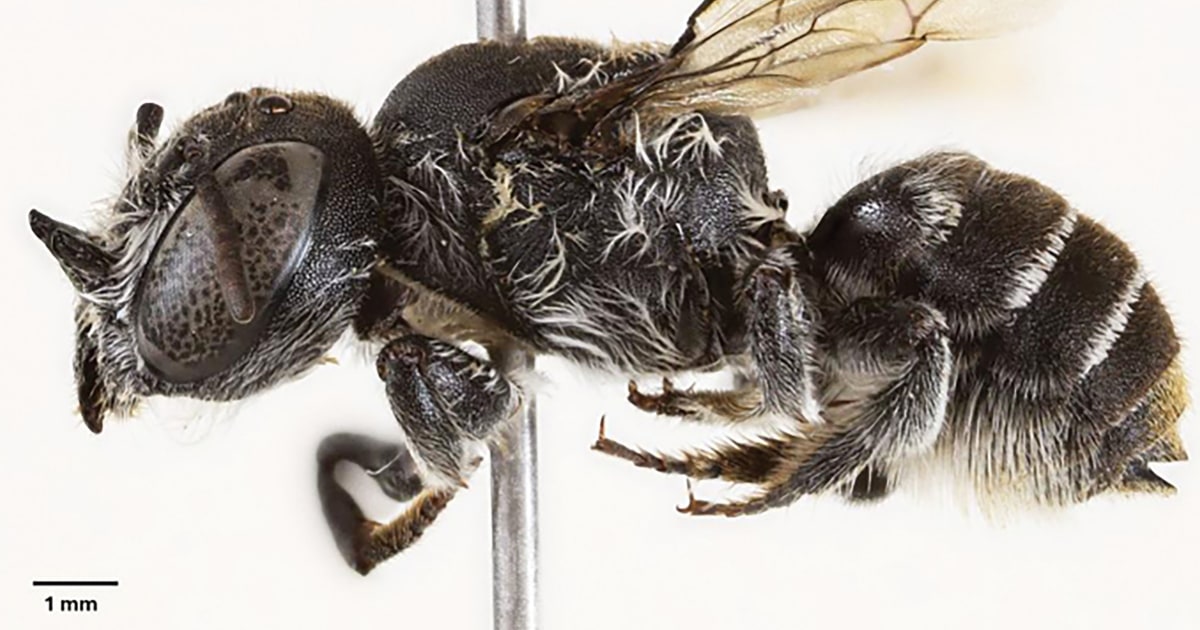Science
Scientists Unveil New ‘Lucifer’ Bee Species in Australia

Scientists in Australia have identified a new species of native bee, named Megachile lucifer, notable for its small, devil-like horns. This discovery, made during a survey of a critically endangered wildflower in Western Australia’s Goldfields in 2019, was detailed in a study published in the Journal of Hymenoptera Research on March 15, 2024.
The female Lucifer bee has distinctive horns, each measuring approximately 0.9 millimeters long. These unique features inspired its name, according to Kit Prendergast, the study’s lead author and an adjunct research fellow at Curtin University. “When writing up the new species description, I was watching the Netflix show Lucifer,” Prendergast stated. “The name just fit perfectly.”
Researchers conducted DNA testing, which confirmed that this new species does not match any known bees in existing databases. It marks the first new member of the Megachile group to be described in over two decades.
Potential Roles of the Horns
While the exact functions of the horns remain unclear, researchers suggest they may assist in accessing flowers, competing for resources, and defending nests. Interestingly, the male bees of this species do not possess horns, raising questions about the evolutionary advantages for females.
The discovery of Megachile lucifer underscores the urgent need to study Australia’s native bee populations, which are currently under-researched. Prendergast emphasized the potential risks facing this new species due to habitat disturbances and climate change. “Without knowing which native bees exist and what plants they depend on, we risk losing both before we even realize they’re there,” she remarked.
Australia is home to around 2,000 species of native bees, with over 300 yet to be scientifically named and described, according to the CSIRO, Australia’s national science agency. The lack of data on these bees contributes to a poor understanding of their conservation status.
Calls for Conservation Action
Tobias Smith, a bee researcher at the University of Queensland, noted that Australia’s native bees are “understudied and data poor.” He highlighted the need for stronger policies to protect these bees from habitat loss, inappropriate fire regimes, and risks associated with megafires.
In a statement to NBC News, Smith encouraged the public to engage with their local environments: “Get outside and look for some native bees and appreciate them.” Such actions could foster greater awareness of the importance of these pollinators and the ecosystems they support.
The identification of the Lucifer bee serves as a reminder of the biodiversity present in Australia and the ongoing challenges faced by its native species. As research continues, the need for conservation efforts becomes ever more pressing to ensure the survival of such unique organisms.
-

 Technology5 months ago
Technology5 months agoDiscover the Top 10 Calorie Counting Apps of 2025
-

 Health2 months ago
Health2 months agoBella Hadid Shares Health Update After Treatment for Lyme Disease
-

 Health3 months ago
Health3 months agoErin Bates Shares Recovery Update Following Sepsis Complications
-

 Technology4 months ago
Technology4 months agoDiscover How to Reverse Image Search Using ChatGPT Effortlessly
-

 Technology1 month ago
Technology1 month agoDiscover 2025’s Top GPUs for Exceptional 4K Gaming Performance
-

 Technology2 months ago
Technology2 months agoElectric Moto Influencer Surronster Arrested in Tijuana
-

 Technology5 months ago
Technology5 months agoMeta Initiates $60B AI Data Center Expansion, Starting in Ohio
-

 Technology5 months ago
Technology5 months agoRecovering a Suspended TikTok Account: A Step-by-Step Guide
-

 Health4 months ago
Health4 months agoTested: Rab Firewall Mountain Jacket Survives Harsh Conditions
-

 Lifestyle5 months ago
Lifestyle5 months agoBelton Family Reunites After Daughter Survives Hill Country Floods
-

 Technology4 months ago
Technology4 months agoHarmonic Launches AI Chatbot App to Transform Mathematical Reasoning
-

 Technology3 months ago
Technology3 months agoUncovering the Top Five Most Challenging Motorcycles to Ride





















